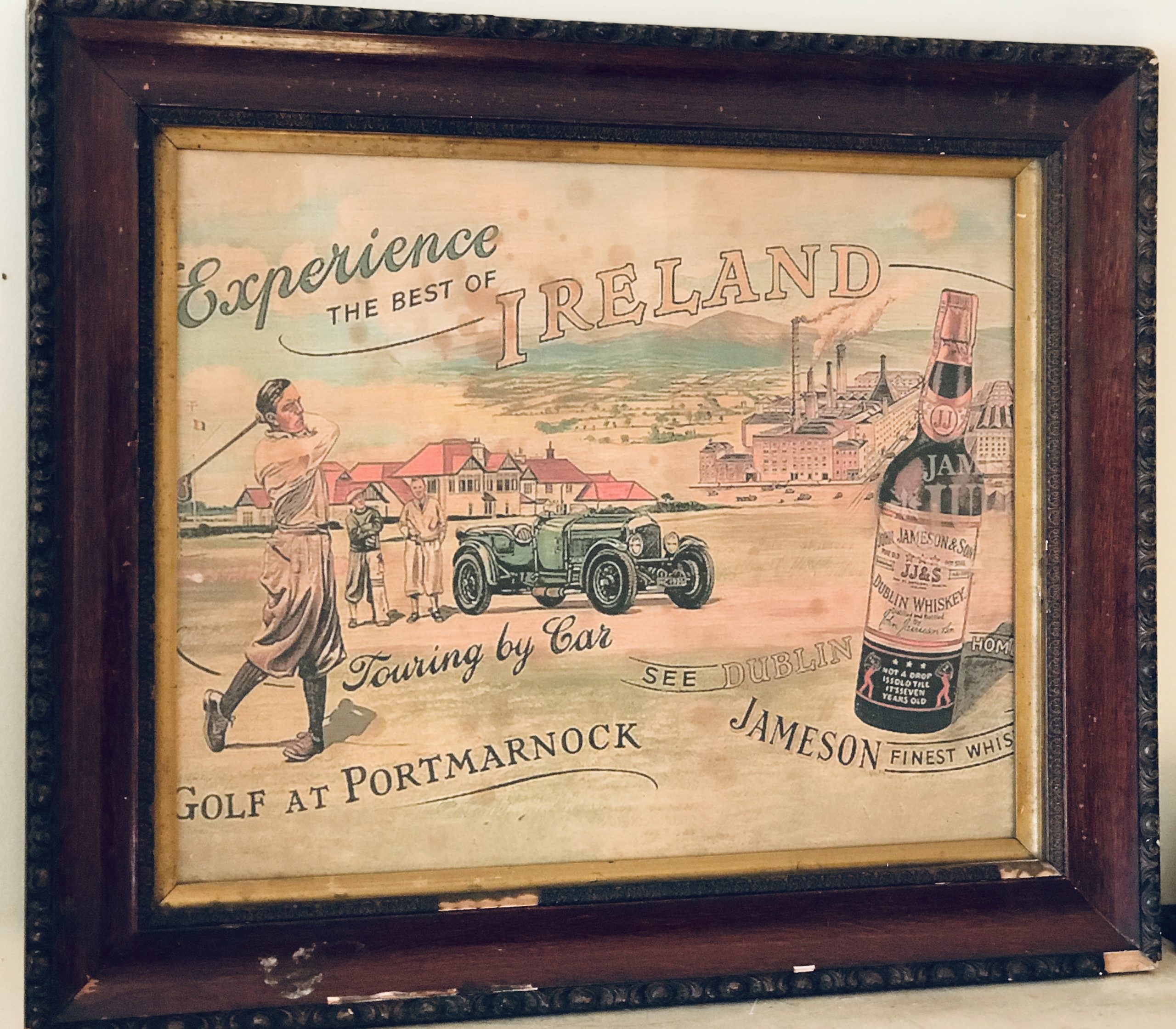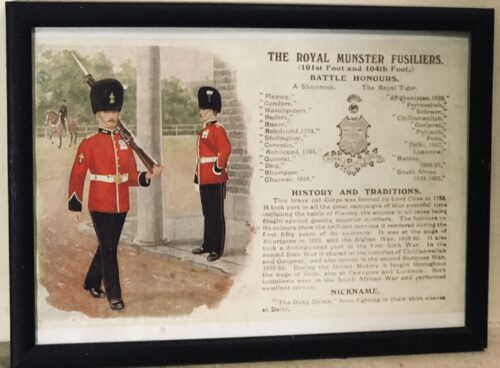55cm x66cm Swords Co Dublin
Experience the best of Ireland touring by car and golf at Portmarnock.Beautiful 1930s advertising print extolling the delights of visiting Ireland,drinking Jameson Whiskey and playing golf at the many wonderful courses in the country especially the famous links featured here,Portmarnock in North Co Dublin,presumably not all at the same time !The famous Jameson distillery in Bow Street in the heart of the city is also featured in this fine portrayal of that era in Dublin which is beautifully showcased in an ornate gold frame.
The Jameson House, (‘St Marnock’s’)
In the 1840s, the distiller, John Jameson acquired nearly 600 acres of land at Burrow, Portmarnock, buying out most of the small-holders there. He built a residence, which overlooked the ruins of the ancient church of St Marnock, after whom he named his house. Keenly interested in golf, he laid out a rudimentary course near the house. Following a fire in 1894, considerable renovation and extension was carried out. An inscription in stone over the original front-door of the house commemorates that work. Nearby was stabling for horses, coach-houses and farm buildings (in the area of the modern office park, ‘The Stables’). An avenue enclosed by iron railings, which survived until the late twentieth century, led from an entrance at South Lodge to the main house. Both gate lodges (‘North’ and ‘South’) have survived, with their distinctive design and (probably) local Plunkett brickwork. The amenities enjoyed by the Jamesons from their country mansion included sailing, shooting and horse-riding. The family’s considerable influence on Portmarnock included the establishment of the first local National School on Jameson land.
The last of the family here, William George Jameson, was best known for his race-horses, his yachting prowess, and his association with high-society and royalty, including the future King Edward V11. After his death in1939, the house was sold and it has since been used as a hotel.
Jameson and the fledging Irish Tourism Board partnered up in terms of selling both the country and a rising brand of Irish Whiskey from the 1930s onwards and a series of adverts ensued.This is a quaint and delightful reminder of times gone by.
John Jameson was originally a lawyer from Alloa in Scotland before he founded his eponymous distillery in Dublin in 1780.Prevoius to this he had made the wise move of marrying Margaret Haig (1753–1815) in 1768,one of the simple reasons being Margaret was the eldest daughter of John Haig, the famous whisky distiller in Scotland. John and Margaret had eight sons and eight daughters, a family of 16 children. Portraits of the couple by Sir Henry Raeburn are on display in the National Gallery of Ireland.
John Jameson joined the Convivial Lodge No. 202, of the Dublin Freemasons on the 24th June 1774 and in 1780, Irish whiskey distillation began at Bow Street. In 1805, he was joined by his son John Jameson II who took over the family business that year and for the next 41 years, John Jameson II built up the business before handing over to his son John Jameson the 3rd in 1851. In 1901, the Company was formally incorporated as John Jameson and Son Ltd.
Four of John Jameson’s sons followed his footsteps in distilling in Ireland, John Jameson II (1773 – 1851) at Bow Street, William and James Jameson at Marrowbone Lane in Dublin (where they partnered their Stein relations, calling their business Jameson and Stein, before settling on William Jameson & Co.). The fourth of Jameson’s sons, Andrew, who had a small distillery at Enniscorthy, Co. Wexford, was the grandfather of Guglielmo Marconi, inventor of wireless telegraphy. Marconi’s mother was Annie Jameson, Andrew’s daughter.
John Jameson’s eldest son, Robert took over his father’s legal business in Alloa. The Jamesons became the most important distilling family in Ireland, despite rivalry between the Bow Street and Marrowbone Lane distilleries.
By the turn of the 19th century, it was the second largest producer in Ireland and one of the largest in the world, producing 1,000,000 gallons annually. Dublin at the time was the centre of world whiskey production. It was the second most popular spirit in the world after rum and internationally Jameson had by 1805 become the world’s number one whiskey. Today, Jameson is the world’s third largest single-distillery whiskey.
Historical events, for a time, set the company back. The temperance movement in Ireland had an enormous impact domestically but the two key events that affected Jameson were the Irish War of Independence and subsequent trade war with the British which denied Jameson the export markets of the Commonwealth, and shortly thereafter, the introduction of prohibition in the United States. While Scottish brands could easily slip across the Canada–US border, Jameson was excluded from its biggest market for many years.
The introduction of column stills by the Scottish blenders in the mid-19th-century enabled increased production that the Irish, still making labour-intensive single pot still whiskey, could not compete with. There was a legal enquiry somewhere in 1908 to deal with the trade definition of whiskey. The Scottish producers won within some jurisdictions, and blends became recognised in the law of that jurisdiction as whiskey. The Irish in general, and Jameson in particular, continued with the traditional pot still production process for many years.In 1966 John Jameson merged with Cork Distillers and John Powers to form the Irish Distillers Group. In 1976, the Dublin whiskey distilleries of Jameson in Bow Street and in John’s Lane were closed following the opening of a New Midleton Distillery by Irish Distillers outside Cork. The Midleton Distillery now produces much of the Irish whiskey sold in Ireland under the Jameson, Midleton, Powers, Redbreast, Spot and Paddy labels. The new facility adjoins the Old Midleton Distillery, the original home of the Paddy label, which is now home to the Jameson Experience Visitor Centre and the Irish Whiskey Academy. The Jameson brand was acquired by the French drinks conglomerate Pernod Ricard in 1988, when it bought Irish Distillers. The old Jameson Distillery in Bow Street near Smithfield in Dublin now serves as a museum which offers tours and tastings. The distillery, which is historical in nature and no longer produces whiskey on site, went through a $12.6 million renovation that was concluded in March 2016, and is now a focal part of Ireland’s strategy to raise the number of whiskey tourists, which stood at 600,000 in 2017.Bow Street also now has a fully functioning Maturation Warehouse within its walls since the 2016 renovation. It is here that Jameson 18 Bow Street is finished before being bottled at Cask Strength.
In 2008, The Local, an Irish pub in Minneapolis, sold 671 cases of Jameson (22 bottles a day),making it the largest server of Jameson’s in the world – a title it maintained for four consecutive years.
















